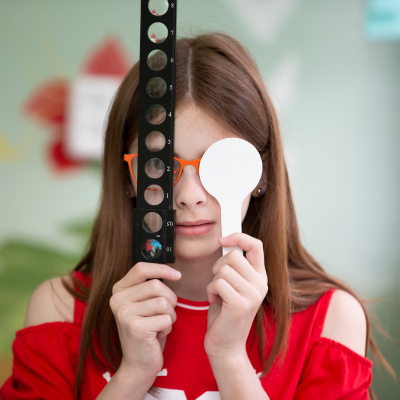
When people think about blindness, they often imagine people experiencing low vision, poor acuity, or a lack of light perception. In spite of those associations, the leading cause of blindness in the United States comes from Cortical/Cerebral Visual Impairment, or CVI. In the case of CVI, the visual impairment is in the brain itself. Visual pathways and the areas of the brain in charge of visual processing can become damaged or underdeveloped, leading to an inability to properly process what one is seeing.
For people with CVI, the difficulty is not necessarily in the act of seeing, but rather the act of understanding what is being seen. Information from the eyes cannot be properly interpreted in the brain. This impacts visual recall (the ability to recognize things that have been seen before), identification of objects, and spatial awareness. For some people with CVI, visual distortions such as swirling vision, “kaleidoscope” vision, or pixilation can occur, especially when experiencing visual fatigue. In some cases, movement or lack of movement can impact the ability for a person with CVI to see an object at all. Others may experience an inability to identify objects except in particular locations or arrangements.
Based on those statements, it’s very easy to see how CVI can manifest in a variety of different ways for different people. Dr. Gordon Dutton, a CVI expert, summarizes it succinctly: “If you’ve met one child with CVI, you’ve met one child with CVI.” The brain is a complex organ, and the visual processing parts can be impacted or improperly developed in so many ways that a universal experience is impossible to create. However, professionals are researching common visual characteristics of people with CVI. The current research, reflected in the upcoming CVI Protocol from Perkins School for the Blind, identifies 16 visual characteristics common in CVI. A person with CVI can experience some or all of these characteristics in varying amounts under varying circumstances. It is important to know that many changeable factors can influence the vision of someone with CVI.
The 16 visual characteristics are:
1) Appearance of the Eyes
The eyes of someone with CVI may be misaligned or turn outward or inward. In many cases with CVI, one eye is prioritized. This can result in a person with CVI tiling their head or holding an object so the favored eye can focus on what they are looking at.
2) Movement of the Eyes
CVI can impact ocular-motor function (the way the eyes move in the head). Shifting gaze from one object to another, or from near distance to far distance, can be especially difficult for someone with CVI. Improper movement of the eyes can influence the ability to see a moving target.
3) Visual Attention
Sometimes known as visual fixation, this attribute has to do with the person’s ability to maintain gaze on a target long enough to process it and produce recognition. Visual fixation can be a taxing activity, and fatigue may reduce the ability to focus on a target. This characteristic also relates to the ability to process other objects when attention is on a target, such as awareness of objects in the peripheral fields.
4) Access to People
Facial recognition and interpreting facial expressions can be difficult for someone with CVI. This is rooted in difficulty processing the visual complexity of faces, a limited ability to maintain visual attention, and difficulty with visual recall and recognition.
5) Response Interval
Response interval, or the time it takes to look at or recognize an object, can be delayed in people with CVI. It can take a person longer to visually engage with something or someone, or to identify what they are looking at.
6) Visual Guidance of the Upper Limbs
Those without CVI typically use visually guided reach when trying to grab something, namely they look at the object, then reach for it. For those with CVI, there is often a disjoint with look and reach. The person may look at an object, then look away and reach for it. When putting an object in a container, they may locate the container visually but turn their attention away when moving their hand toward the container. Additionally, people with CVI may over- or under-reach for objects.
7) Visual Guidance of Lower Limbs
Similar to the characteristic before this one, a person with CVI may have difficulty with determining the proper placement of their feet. This can manifest in miss-stepping, tripping, and having trouble with obstacles on the ground, such as stairs, curbs, objects, and changes in terrain.
8) Sensory Integration
For some people with CVI, competing sensory information such as touch or sound can fall to the wayside when they are using their vision. It may become hard to hear or feel sensations when their attention is on their vision.
9) Visual Field Abilities
“Visual fields” refers to different regions of one’s vision, such as central, peripheral, left and right, and upper and lower. A person with CVI may not consistently recognize objects or maintain visual attention to objects in certain visual fields. They may also prioritize one visual field when looking at something.
10) Impact of Motion
There is often a complicated relationship between movement and visual processing for people with CVI. For some, movement can encourage visual attention. For others, movement in the environment can become a distraction. In some cases, there is a delay in the ability to visually follow objects as they move. This means that fast-moving objects like cars or toys can pose a risk because their speed cannot be properly determined.
11) Impact of Spacing/Object Arrangement/Clutter
Games like Where’s Waldo and I Spy are difficult because of visual complexity: the more objects there are, and the more tightly arranged they are, the harder it is to see them. This same principle can be especially difficult for people with CVI. Often, people with CVI can only process a certain number of objects in a set in front of them, and may need them spaced out to properly see them. Likewise, an object, even a favorite toy, can be overlooked when it is in a complex environment like a shelf, or removed from familiar context.
12) Form Accessibility
This characteristic has to do with understanding that an object is consistently the same object, even in different visual forms. For example, someone without CVI could look at a school bus in person, a color photo of a school bus, and a black and white clipart cartoon of a school bus, and still understand that these are all representations of a school bus. Someone with CVI may not be able to identify an object in a certain form, even if they can identify it in another form.
13) Impact of Color
Color can be a valuable tool for people with CVI. It can be used to help them visually categorize objects, find them in an array, or maintain visual attention, even in complex environments. Many people with CVI have an “anchor color” that they are particularly drawn to, or benefit from bright, high-contrast colors to stay focused on a target.
14) Impact of Light
Like color, light can be a useful guide for people with CVI. Some practice light gazing, where they are more likely to focus on lights during times of visual fatigue. Shining a light on an object or using backlighting can help a person with CVI to better interact with that object. People with CVI may conversely experience light sensitivity. It is important to consider all the ways light can influence vision.
15) Visual Recognition
This characteristic reflects the ability to identify an object a person is looking at. Someone with CVI may recognize a certain cup they usually use or enjoy, like a favorite mug. However, if they are given a different cup or mug, they may not recognize what it is, even if the objects are similar.
16) Visual Curiosity
Because looking at objects and processing what they are seeing can be so hard for people with CVI, they may be less inclined to want to look at new things or to visually explore their surroundings. While most have the urge to “take it all in” when going to an exciting new place, those with CVI can find it exhausting or even frightening, so there is little appeal in looking at new and unfamiliar things.
As stated, a person with CVI may experience some or all of these visual characteristics. They may appear in different levels of severity, and that severity may be influenced by things like the environment and visual fatigue. The role of a teacher of students with visual impairments is to assess the presence of the characteristics and understand how they impact access to schoolwork and the world at large. CVI cannot be “cured,” but with an understanding of the characteristics, goal-oriented practice of skills, and proper accommodations and tools, a student with CVI can learn to thrive in a visually complicated world.
To learn more about CVI and hear some testimonials from people with CVI about their experiences, click here.
We provide services for those experiencing Cortical/Cerebral Visual Impairment (CVI). If you or someone you know could benefit from our services, contact us at 603-224-4039 or email us at [email protected].
About the Author: Erika Teal is a Teacher for the Visually Impaired at Future In Sight.

